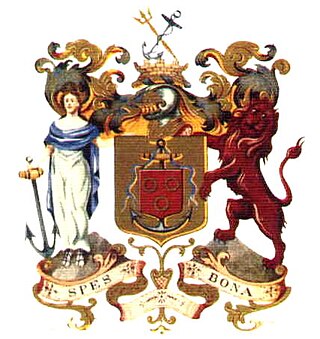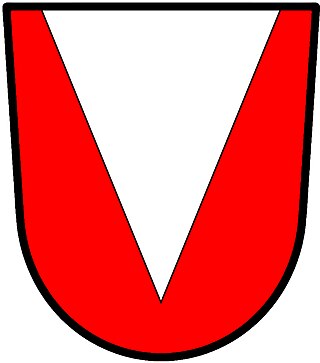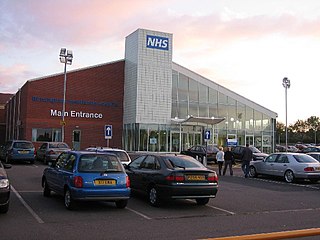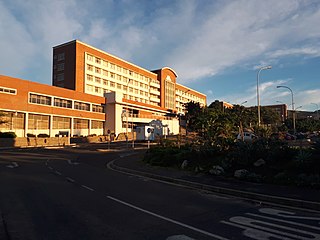
In heraldry, an ordinary is one of the two main types of charges, beside the mobile charges. An ordinary is a simple geometrical figure, bounded by straight lines and running from side to side or top to bottom of the shield. There are also some geometric charges known as subordinaries, which have been given lesser status by some heraldic writers, though most have been in use as long as the traditional ordinaries. Diminutives of ordinaries and some subordinaries are charges of the same shape, though thinner. Most of the ordinaries are theoretically said to occupy one-third of the shield; but this is rarely observed in practice, except when the ordinary is the only charge.

Groote Schuur Hospital is a large, government-funded, teaching hospital situated on the slopes of Devil's Peak in the city of Cape Town, South Africa. It was founded in 1938 and is famous for being the institution where the first human-to-human heart transplant took place, conducted by University of Cape Town-educated surgeon Christiaan Barnard on the patient Louis Washkansky.

St James's University Hospital is in Leeds, West Yorkshire, England and is popularly known as Jimmy's. It is one of the United Kingdom's most famous hospitals due to its coverage on television. It is managed by the Leeds Teaching Hospitals NHS Trust.

Simon's Town, sometimes spelled Simonstown, is a town in the Western Cape, South Africa and is home to Naval Base Simon's Town, the South African Navy's largest base. It is located on the shores of False Bay, on the eastern side of the Cape Peninsula. For more than two centuries it has been a naval base and harbour. The town is named after Simon van der Stel, an early governor of the Cape Colony.

Royal Brompton Hospital is the largest specialist heart and lung medical centre in the United Kingdom. It is managed by Guy's and St Thomas' NHS Foundation Trust.

Leeds General Infirmary, also known as the LGI, is a large teaching hospital based in the centre of Leeds, West Yorkshire, England, and is part of the Leeds Teaching Hospitals NHS Trust. Its previous name The General Infirmary at Leeds is still sometimes used.

The coat of arms of Cape Town is the traditional symbol of the municipality of Cape Town. The original arms from the 20th century are no longer in official use, though no new arms have yet been adopted.

Musgrove Park Hospital is a large NHS hospital located in Taunton, Somerset, England, run by Somerset NHS Foundation Trust. Originally a US Army General Hospital during the Second World War, it became an NHS hospital in 1951.

The Valkenberg Hospital is a large, government-funded, tertiary psychiatric hospital in the city of Cape Town, South Africa.

In heraldry, a pile is a charge usually counted as one of the ordinaries. It consists of a wedge emerging from the upper edge of the shield and converging to a point near the base. If it touches the base, it is blazoned throughout.
In South Africa, private and public health systems exist in parallel. The public system serves the vast majority of the population. Authority and service delivery are divided between the national Department of Health, provincial health departments, and municipal health departments.

The Ellis Island Immigrant Hospital was a United States Public Health Service hospital on Ellis Island, in New York Harbor, that operated from 1902 to 1951. The hospital is part of the Statue of Liberty National Monument. While the monument is managed by the National Park Service as part of the National Parks of New York Harbor office, the south side of Ellis Island, including the hospital, is managed by the non-profit Save Ellis Island Foundation and has been off-limits to the general public since its closing in 1954.

Tygerberg Hospital is a tertiary hospital located in Parow. The hospital was officially opened in 1976 and is the largest hospital in the Western Cape and the second largest hospital in South Africa, with the capacity for 1899 beds. It acts as a teaching hospital in conjunction with the Stellenbosch University's Health Science Faculty. To become a patient at Tygerberg, a person must be referred by a primary or secondary health care facility. Over 3.6 million people receive health care from Tygerberg, either directly or via its secondary hospitals, such as Paarl and Worcester Hospital. During the normal working day there are about 10,000 people on hospital grounds.

Heartlands Hospital is an acute general hospital in Bordesley Green, Birmingham, England. It is managed by University Hospitals Birmingham NHS Foundation Trust.

Karl Bremer Hospital is a hospital, situated in Bellville, Western Cape, South Africa. It was opened in 1956 with one ward. It was originally an academic hospital for medical students of Stellenbosch University and was utilised for this purpose until 1976, after which it changed to a hospital catering for private patients.

The Miller General Hospital was a hospital in Greenwich, London from 1884 until 1974. It was developed adjacent to an earlier dispensary, and was the first British hospital designed with circular wards, and one of the first to have an X-ray department.

The Transvaal Memorial Hospital for Children, based in Johannesburg, was the first dedicated children's hospital in South Africa when it opened in 1923. The hospital would remain open until 1978 when its functions were moved to the then newly opened Johannesburg General Hospital. The building is a heritage listed monument and parts of the building are currently used by community groups dedicated to the service of children.
Helen Joseph Hospital is a public hospital based in Auckland Park, Johannesburg, South Africa. Prior to 1997, it was known as the J.G. Strijdom Hospital. As a teaching hospital, its affiliated to the University of Witwatersrand's Medical School.

Dulwich Community Hospital was a hospital located in Dulwich, in South London.
The Guthrie Cortland Medical Center, formerly known as Cortland Regional Medical Center, is a large rural hospital in Cortland, New York founded in 1891. Cortland Regional Medical Center was ranked the top hospital in New York State by Centers for Medicare and Medicaid in 2015 and 2017. In 2016, it was received the Blue Distinction Center+ for Maternity Care award.


















